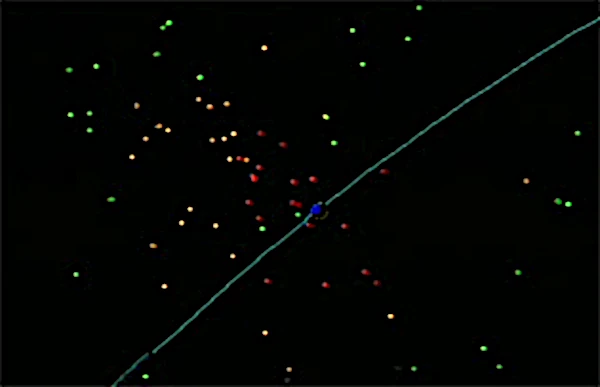
The asteroid 99942 Apophis, discovered in 2004, quickly caught the attention of astronomers worldwide. In 2029, it will pass just 31,600 km from Earth's surface, well within the geostationary orbit of satellites (35,786 km). At this distance, Apophis will be visible to the naked eye from certain regions of the globe.
This flyby, the closest ever observed for an object of this size (340 meters in diameter), represents a unique case study for orbital mechanics and planetary defense strategies. The passage of the asteroid Apophis at a distance of about 31,600 km from Earth on April 13, 2029 is the result of precise measurements, complex orbital modeling, and advanced celestial mechanics techniques.
The perigee of 31,600 km is measured from the center of the Earth. This places Apophis inside the geostationary orbit (35,786 km), but well above the atmosphere. Its trajectory will not cross any known major satellites (operators and agencies have checked for collision risks).
Thanks to precise radar observations made notably by Goldstone and Arecibo, NASA has ruled out any risk of collision with Earth for 2029. However, Apophis's trajectory will be significantly altered by Earth's gravitational effect—a phenomenon called a "gravitational keyhole". If the asteroid passes through a narrow region of space (about 600 meters wide), its trajectory could be deflected in a way that would cause an impact on a future return, notably in 2036 or 2068.
Current calculations, based on N-body dynamics and gravitational perturbations, show that the impact risk for these dates is less than 1 in 150,000. But orbital uncertainties, the Yarkovsky effect (long-term thermal perturbation), and future interactions with other objects in the solar system require constant monitoring.
| Orbital Elements of Apophis (epoch: March 30, 2024) | |
|---|---|
| Semi-major axis (a) | 0.92255214 AU |
| Eccentricity (e) | 0.19129073 |
| Inclination (i) | 3.33973639° |
| Perihelion (q) | 0.74607647 AU |
| Aphelion (Q) | 1.09902781 AU |
| Orbital period (P) | 0.8861 year (≈ 323.66 days) |
| Argument of perihelion (ω) | 126.6832° |
| Longitude of the ascending node (Ω) | 203.96° |
| Mean anomaly (M) | 195.65° |
| Date of next perihelion | February 12, 2025 |
The threat posed by Apophis has stimulated research on asteroid deflection technologies. Missions like DART (NASA, 2022) have demonstrated the possibility of altering the trajectory of a body through kinetic impact. Apophis offers an opportunity for in-situ testing: several agencies are considering sending probes to study its internal structure, its density (estimated at about \( 3\, \text{g/cm}^3 \)), and its silicate composition.
An impact from Apophis would release kinetic energy equivalent to more than \( 1000\, \text{Mt} \) of TNT, about 80,000 times the energy of the Hiroshima bomb. With its 340 meters in diameter, an estimated density of \( 3\, \text{g/cm}^3 \), and a typical impact speed of \( \sim 12\, \text{km/s} \), Apophis would pass through Earth's atmosphere without completely disintegrating. It would hit the ground, forming a crater several kilometers in diameter and causing major damage on a regional or even continental scale, depending on the impact zone.
Apophis will not hit Earth in 2029, 2036, or 2068, but it brutally reminds us that our planet is not safe from a cataclysmic event from the sky. The most critical approach is that of April 13, 2029, but no collision is expected in the 21st century.
The precise tracking of near-Earth objects, a detailed understanding of their orbits, and the development of deflection technologies are becoming a scientific and strategic imperative. The question scientists must answer is "When could such an impact occur?"
| Year | Distance (km) | Impact Risk | Remark |
|---|---|---|---|
| 2029 | 31,600 | 0% | Record passage, highly studied |
| 2036 | ~14 million | 0% | Risk canceled in 2013 |
| 2068 | ~38 million | 0% | Separation of more than 100 lunar diameters |
| 2116 | ~200,000 km (possible) | < \(10^{-6}\) | Possible orbital resonance studied |
N.B.:
From a purely orbital point of view and according to current models of celestial mechanics and observations, beyond 2116, predictions become very uncertain due to the chaotic dynamics of the gravitational system.